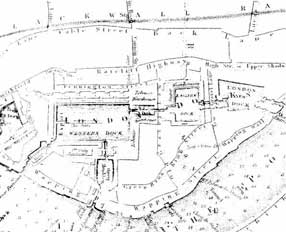Where was Sailortown?
It was not, however, just the ships that disappeared. Ports around the world built infrastructure to deal with their regular ship traffic and a thriving dockside world catering to the needs of ships and seafarers, but these also ceased to exist.
 These areas of town were called "sailortowns" and "docklands". Dockland was a large area comprising of the port's dock system and the adjacent seafaring services. Within or near the docklands there was usually a place known as sailortown, which would include services for the comfort of seafarers, like pubs and taverns for food and drink, boarding houses for accommodations and shops for buying supplies like clothing, tools and provisions. In the docklands there was usually a police station, a magistrate's court and a shipping office.
These areas of town were called "sailortowns" and "docklands". Dockland was a large area comprising of the port's dock system and the adjacent seafaring services. Within or near the docklands there was usually a place known as sailortown, which would include services for the comfort of seafarers, like pubs and taverns for food and drink, boarding houses for accommodations and shops for buying supplies like clothing, tools and provisions. In the docklands there was usually a police station, a magistrate's court and a shipping office.
Sailortown and dockland were often written about as generic locations—international everyplaces existing in nearly every port. Cecily Fox Smith wrote that "dockland, strictly speaking, is of no country—or rather it is of all countries".
Smith and other quasi-folklorists like David Bone went in search of this elusive world called sailortown in the 1920s and '30s. Enticed by stories and songs of pub brawls, cunning prostitutes and underhanded boarding house masters, these searches revealed that sailortowns had moved, changing with the geography of the city and the orientation of the docks. Even though people like Smith seemed to be convinced that the sailortown was a space firmly contained within its boundary of streets, the changing geography of London's sailortown shows that it was less solid than people thought (Burton 2001).
Writing on Sailor town
The following song "Whiskey Johnnie" is from David Bone's Capstan Bars (1931). Bone's work reveals a majority of seafaring songs focused on exploits ashore in port, whether drinking, fighting, or just getting by.
|
Oh, whiskey is the life of a man. 'Twas whiskey made me pawn my clothes. Oh, whiskey drove my mother mad. |
Oh, whiskey here, an' whiskey there. Oh, some likes gin an' some likes beer. If whiskey was a river, an' I could swim. |
Folksinger and author, Stan Hugill's view of sailortown:
The following extracts from Stan Hugill's Sailortown (1967), show the repetitive descriptions of sailortown. As Hugill moves away from British and American sailortowns, he ceases to describe them, relying on his earlier statements. Hugill's descriptions of seafarers ashore rely almost exclusively on generalisation, titillation and shock-value.
Cardiff: "It was an area where the police always went in pairs, and often in three. In the side-streets off the 'Parade' were to be found seamen of all nationalities. The alleys and courts of the neighbourhood stank of bad sanitation, and of squalid dirt" (128-130).
New York: "Here, in the hundreds of drinking dens, dance halls, tattoo parlours, skittle alleys, boarding-houses, and tailor shops, were to be found the seamen of all nations" (158).
London: "This area was a maze of narrow, cobbled lanes, alleys, and courts, chock-a-block with overflowing humanity of the veriest dregs. All types of seamen would be rolling by" (114-115).
Liverpool: "The streets already mentioned would be agog with sailors of all nations, in various stages of sobriety or drunkenness. Nightly the gutters were filled with broken bottles and out-for-the-count tars and beachies" (97, 101).
San Francisco: "[Pacific Street] was a street of vice; a thoroughfare crowded with gamblers, thieves, bludgers, harlots, drunken sailors, and miners, its gutters cluttered with pools of spew, broken bottle splinters, and half-soused bodies, its sides lined with brothels, grog-shops, and 'hops'" (209).
Sailortown was not a contained area which was purposefully created to serve the needs of sailors, as it is so often described. Rather, it was a place where sailors went, but it catered to others, had other purposes, grew, shrank and moved with the fortunes and misfortunes of the area's patrons or nearby development. The descriptions of sailortown by Hugill and Smith were preoccupied with stereotypes of seafarers and the idea of sailortown inhabiting a space with rigid borders and specific clientele.
